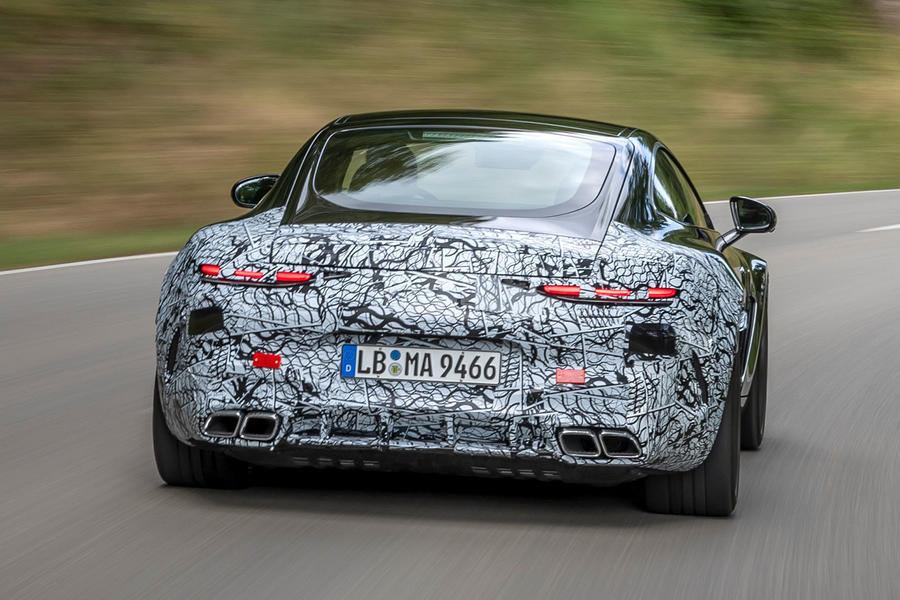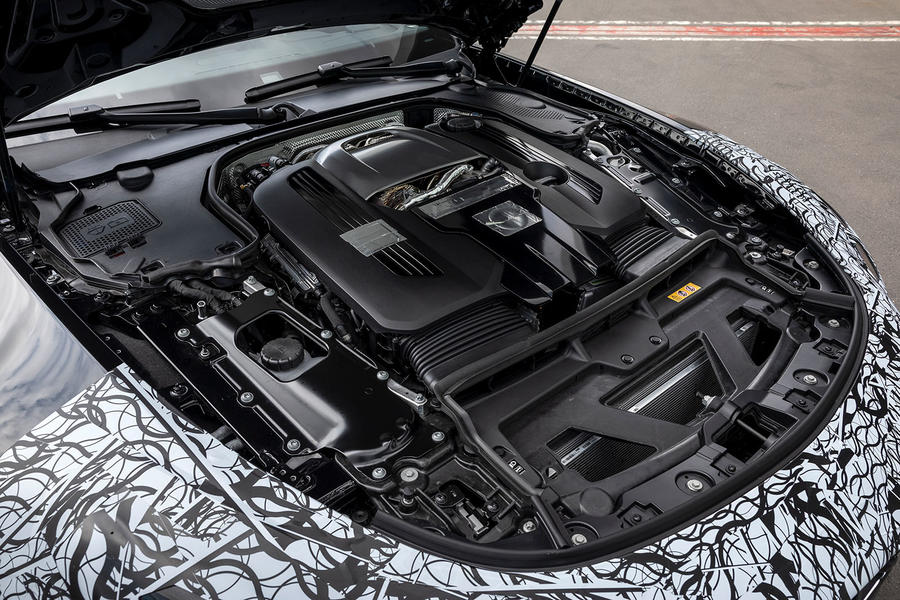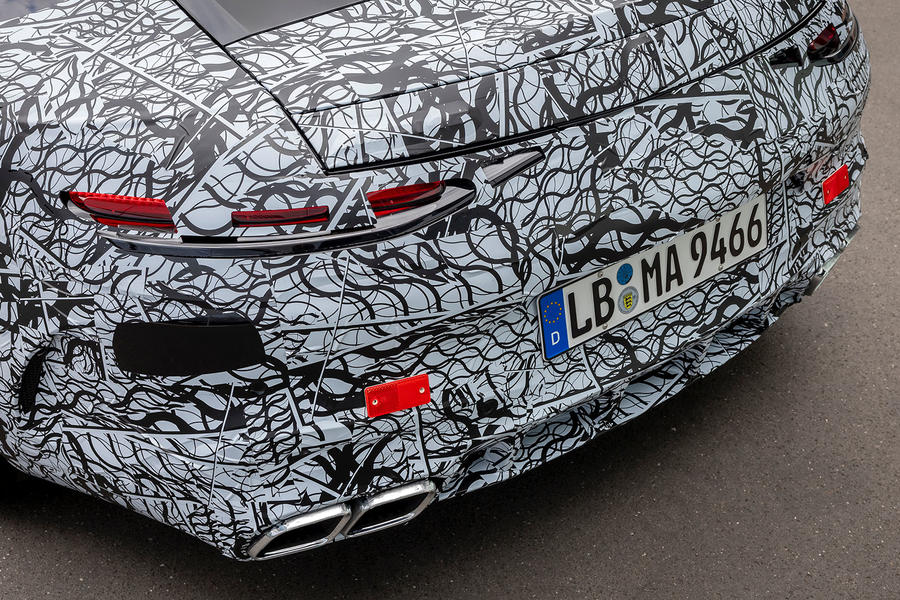The GT gets bespoke treatment for the front grille and a rakish rear roofline
Stiffened, overhauled V8 coupĂ© will be launched at Pebble Beach – and we’ve already ridden in it
The new, hotly anticipated, second-generation Mercedes-AMG GT will be unveiled on 17 August at Pebble Beach Concours d’Elegance as an old-school, SL-twinned rival to the Porsche 911.
With development handled entirely by the Mercedes-AMG performance division in Affalterbach, it follows soon after the arrival of the closely related seventh-generation Mercedes-AMG SL roadster. The GT will share the bulk of the SL’s underpinnings, effectively becoming a hard-top coupĂ© version of that car.
Over the previous car, which launched in 2014, it gets subtle visual differences, including a more rakish rear roofline and a bespoke treatment for the front grille. When it’s revealed, unique wheel designs, paint colours and option packs could be introduced to further differentiate the cars.
With the launch set to take place next week, the car will be introduced as the fifth model to have been developed by Mercedes‑AMG itself, after the SLS, the first-generation car, the GT 4‑Door Coupé and the SL.
A limited-edition SL will also be launched at the event, celebrating the German firm’s Manufaktur customisation programme, which allows customers to specify their cars with bespoke paint colours and options.

Mercedes-AMG promises the new GT will be an old-school AMG, staying true to many of the brand’s traditional values and something that resonates strongly with enthusiasts. Speculation has only grown since AMG announced the new C192-generation model would be twinned with the latest SL.
So to find out if the 2023 car will be bigger and heavier, have its performance and character bound by ever-stricter emissions regulations and, perhaps, become less focused than the original, Autocar joined AMG’s new CEO, Michael Schiebe, for a ride in a near-finished prototype.Â
“Before you ask, we’re only going to build it as a coupé,” he said, immediately.
“There is no shame in it sharing its DNA with the SL, which takes the roadster role in our portfolio.” The two AMG cars are based on the same Modular Sport Architecture platform, a lightweight spaceframe-style structure that uses a combination of aluminium, steel, magnesium and plastic composites.
Schiebe said the new GT will be more rigid than the SL, which is to be expected, given that it has a fixed roof and other additional stiffening measures, including substantial engine bay bracing.
Dimensionally, the new GT has grown. Official details have not yet been released, but we expect it to mirror the latest SL with a length of around 4705mm –Â 159mm longer than the old model.
The wheelbase has increased by 70mm to 2700mm too, and the interior (identical to the SL’s) has been repackaged, which provides the scope for a set of rear seats and a larger boot.

“The feedback we got from customers was to keep the performance but broaden the scope to make it a more amicable car in everyday driving conditions. We’ve got people who use the GT for weekend trips and longer,” said Schiebe.
At launch, cars will use AMG’s twin-turbocharged 4.0-litre V8 engine. Schiebe would not go into detail yet but said it has been engineered with Euro 7 emissions regulations in mind. He also hinted at electrified models further down the line: “They are not planned from the beginning but we’re well prepared to bring them online when the regulatory framework demands it.”
Will the new GT line-up encompass as many models as its predecessor, which, at last count, ran to 11? “Wait and see,” said Schiebe, adding: “We already offer the SL in 43, 55 and 63 models.” In a development brought to the SL, the previous Speedshift MCT seven-speed dual-clutch transaxle of the first-generation GT is replaced by a nine-speed gearbox mounted directly to the engine.
As before, it offers both manual and automatic shifting. However, new for 2023 will be a fully variable four-wheel drive system in place of the traditional rear-wheel drive.

Noticeable from the passenger seat is just how close the new model feels to the original. Despite larger dimensions, a more spacious interior and a heavily reworked drivetrain, it still feels like a GT.
There is the same deep staccato engine sound, the same elongated view down the bonnet and the same exuberant accelerative force under load in Sport Plus mode.
It is traditionally AMG in character. Schiebe admitted the larger dimensions, the new interior layout and the addition of four-wheel drive have inevitably increased weight. He’s confident, however, that the new GT is every bit as dynamically adept as its predecessor, if not more so.
He said the decision to go with four-wheel drive opens up a new dimension for the GT. “We have a fully variable apportioning of power front to rear. That means that you can not only decide to drive to the Alps in June or July, but also in October or November, because you feel safe,” he said.

The double-wishbone front and multi-link rear suspension, with variable damping control and active anti-roll functions, is uniquely tuned. The new GT is firmer than the SL, but it gives the impression that it delivers greater compliance and better absorption of road shock than the original model.
On the way back to AMG’s HQ in Affalterbach over undulating country roads, Schiebe identified what he believes to be the defining characteristics of the company’s new flagship. “It is still a supercar with an ability to excite and engage the driver on a very high level,” he said. “But it now has greater comfort and ease of use. It is a more agreeable car on an everyday basis.”
Everything else you need to know about the new AMG GT
The current-generation GT is exclusively a two-seater, but with the SL adopting a pair of rear seats for the first time in several generations and direct rivals in the form of the Porsche 911 and Ferrari Roma carrying a pair of child-sized buckets in the rear, AMG will offer the car with rear seating.Â
The GT will follow largely the same formula as its convertible sibling. It rides on the same all-new aluminium platform, claimed to boost transverse rigidity by 50%, which allows the engine and axles to be mounted lower in the chassis.Â
It will also use the same twin-turbocharged 4.0-litre V8 as the two SL variants already revealed, although likely in just the more potent state of tune, with 577bhp and 590lb ft for a sub-4.0sec 0-62mph time and a top speed nudging 200mph. A plug-in hybrid GT 63e variant should follow soon after, using a variation of the 831bhp electrified V8 deployed in the new Mercedes-AMG GT 4-Door CoupĂ© PHEV.Â
It remains to be seen if the hard-top car will weigh substantially less than the 1970kg SL 63, but more details are expected as the car’s launch date nears.
Additional reporting by Felix Page
Source: Autocar